 Parsi Times presents the first part of the interesting series on some of the prominent statues of Mumbai, by Dara Khodaiji
Parsi Times presents the first part of the interesting series on some of the prominent statues of Mumbai, by Dara Khodaiji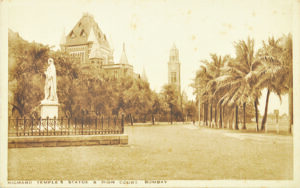
Mumbai has some of the finest displays of statues of British, Parsis and great Indians at various locations, mostly in South Mumbai. These speak of the history of our nation and our city in stones, marbles and bronze. Some of the most beautiful and elaborately decorated ones were that of the British monarchs and assortment of governors, viceroys and other Brit. VIPs.
Of these – three stand out most to me. The most beautiful being Queen Victoria’s statue, with its tall, elegantly canopy in Neo-Gothic style, standing nearly 42 feet tall. It was, sometime in the early fifties, vandalized by a person with patriotic zeal and a philistine too, by hurling a stone at it and breaking the well-sculpted royal nose. A great many people were not amused.
The other statute was the equestrian statue of the then Prince of Wales, who later assumed throne as King Edward VII. While the Emperor and the Raj is long gone and forgotten, the area 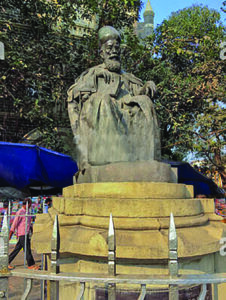 where the statute stood is still popular today as ‘Kala Ghoda’, the black horse. To me, the third most impressive statue was that of Sir Richard Temple that stood outside the entrance to the Oval Maidan just opposite Bhikha Behram well. These three, along with many other British statues, now lie in an Ozymandiac ruin somewhere unseen, unappreciated and probably dirty, far away from the gaze of those who might feel offended and hurt by these figures of erstwhile rulers. But the fact remains, they were exquisite works of art.
where the statute stood is still popular today as ‘Kala Ghoda’, the black horse. To me, the third most impressive statue was that of Sir Richard Temple that stood outside the entrance to the Oval Maidan just opposite Bhikha Behram well. These three, along with many other British statues, now lie in an Ozymandiac ruin somewhere unseen, unappreciated and probably dirty, far away from the gaze of those who might feel offended and hurt by these figures of erstwhile rulers. But the fact remains, they were exquisite works of art.
One also finds a number of statues of Parsis – the community Sethias, philanthropists, lawyers, judges, financial geniuses… starting from the right side of the Flora Fountain one can espy that of Dr. Dadabhai Naoroji, the first Indian to be elected to the British House of Commons, and one of the greatest of the Indian freedom fighters. He had the courage to stand up in the Mother of all 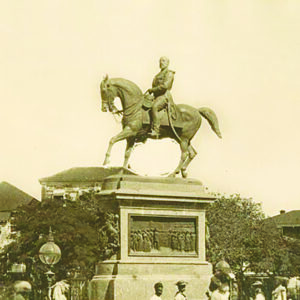
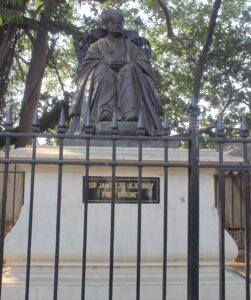 Parliaments and speak on Britain’s ‘economic drain policy’ that India was subjected to. He served as 2nd, 9th, and 22nd President of the Indian National Congress. He refused to be conferred knighthood. In the words of Sir Narayan Chandavarkar, “It is no exaggeration to say, it is not marring the beauty of the religion to say that he was the second Zoroaster sent to India to make the sun of righteousness and India’s future progress shine more and more by means of our pure thoughts, our pure words and our pure deeds.”
Parliaments and speak on Britain’s ‘economic drain policy’ that India was subjected to. He served as 2nd, 9th, and 22nd President of the Indian National Congress. He refused to be conferred knighthood. In the words of Sir Narayan Chandavarkar, “It is no exaggeration to say, it is not marring the beauty of the religion to say that he was the second Zoroaster sent to India to make the sun of righteousness and India’s future progress shine more and more by means of our pure thoughts, our pure words and our pure deeds.”
Walking towards Churchgate station, we encounter the statue of Sir Hormasji Cowasji Dinshaw of Aden, Justice Ranade and Gopal Krishna Gokhle.
Further down the road, between Churchgate station and Eros Theatre, at the cross roads, stands the statue of Sir Dinshaw Edulji Vacha – one of the three greatest Parsi patriots. He was the founding member of the Indian National Congress and served as its President in 1901.
Vacha – one of the three greatest Parsi patriots. He was the founding member of the Indian National Congress and served as its President in 1901.
Outside the Oval Maidan, on the north side, sits Sir Jamsetjee Jejeebhoy – the first Indian to become the Baronet. He was a businessman, an adventurer, a philanthropist, a knight sans compare, sans reproche. He sits majestically, with an air of benevolence, surveying the city that once lionized him. He was the first 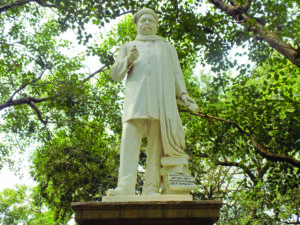 person outside Europe to be knighted and later, elevated to
person outside Europe to be knighted and later, elevated to 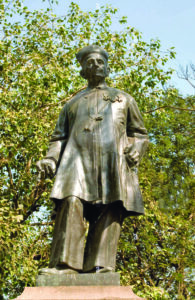 baronetcy. His statue standing in the foyer Sir J J Hospital is revered by all who visit. It is always surrounded by garlands, flowers and candles. My chauffeur, who grew up on the grounds of the J J hospital, as his parents used to work there, would tell me that no matter what the occasion in any of the families living there on the hospital campus, whether there was a birth in the family, or birthdays, or marriages, examinations or outings, Sir Jamsetjee’s blessings were first sought for luck and success.
baronetcy. His statue standing in the foyer Sir J J Hospital is revered by all who visit. It is always surrounded by garlands, flowers and candles. My chauffeur, who grew up on the grounds of the J J hospital, as his parents used to work there, would tell me that no matter what the occasion in any of the families living there on the hospital campus, whether there was a birth in the family, or birthdays, or marriages, examinations or outings, Sir Jamsetjee’s blessings were first sought for luck and success.
In the foyer of my school, Sir J J Fort Boys High School too, is a similar statue. Students entering the building would invariably touch his feet in grateful thanks for his benevolent work of spreading education, a legacy that continues today, 174 years after it was established. This is the man I have admired since my childhood. He has left footprints in the sands of time that cannot be easily eroded.
(Watch this space for the second part of this series).
- 48 And Still Going… Er… Um.. Strong! - 8 February2025
- Parsis – The Sweetest Bunch! - 28 December2024
- Hep Grannies, Swingin’ Grandpas!’ - 10 August2024